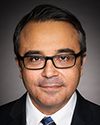Thank you very much, Mr. Chair.
I am honoured to have the opportunity to appear before you today, and I am honoured to appear with my colleagues, Dr. Drummond and Dr. Ovens of CAEP and Ms. Silas of CFNU.
That we are gathered here virtually rather than physically simply serves to further underscore the gravity of the situation we all face as Canadians.
In exploring Canada’s response to the COVID-19 pandemic, I am pleased to represent the unique perspective of the front-line workers who are entrenched in the daily battle to defeat it.
Again, my name is Dr. Sandy Buchman. I have over 20 years of experience in practising comprehensive family medicine, with a special interest in primary care, cancer care, palliative care, HIV/AIDS, global health and social accountability. I have spent the last 15-plus years practising home-based palliative care, including providing palliative care to the homeless in Toronto.
Today I appear before the committee as president of the Canadian Medical Association.
I wasn’t around for the Spanish flu in 1918, but the CMA was. I wasn’t the president when SARS hit in 2003 or when H1N1 came in 2009, but the CMA was there. The organization that represents Canada’s physicians has witnessed significant outbreaks during its 153-year history. The Canadian Medical Association represents the interests and well-being of the very physicians who care for our nation’s health. I have the humble honour today to speak for our members, those front-line physicians.
As we are all aware, the COVID-19 pandemic is evolving rapidly. We did not get to control if it came to us and we did not get to control when it came to us, but to the degree to which we are equipped, we can control how we respond to COVID-19.
Messages about the health of Canadians and the health of the economy mean nothing without an equal pillar: the health and safety of our front-line workers. At this point, it is of incredible urgency that we support our care providers and that we understand how important it is to be armed with information to make the decisions to make it happen.
We have heard through our members that the inadequate supply of personal protective equipment is even starker than has been reported, so we launched a rapid survey to collect real on-the-ground stories from physicians. On March 30 and March 31, we heard from close to 5,000 physicians. They represented an almost equal split between community-based physicians and hospital-based physicians. This poll was essential to accurately inform us of the situation at the front lines. We now have a clear snapshot of physicians’ observations and experiences around the personal protective equipment that is available to them. That equipment includes surgical masks, N95 respirators, face shields, gowns and gloves.
The feedback received shows a dark reality. The results don’t just reveal the issues with supply and distribution of PPE; the results unveil the enormous lack of information available about the status of supplies and how health providers can get supplies. The toll that is paid for this uncertainty weighs heavily on health care workers across the country. They are scared. They are anxious. They feel betrayed. They don’t know what supplies are available.
More than a third of physicians in community care—that is doctors’ offices, walk-in clinics and health hubs—said they believed they would run out of masks, respirators, eye and face shields, and goggles and glasses within two days or less, or indeed they had already run out. That was just seven days ago. Seventy-one per cent of physicians in community care have tried to order supplies in the past month, but fewer than 15% received confirmation that supplies were en route or had been received. In Nova Scotia, only 2% of physicians indicated that their recent order had been received or was being shipped. That’s fewer than 50 doctors.
When it comes to alternative supply sources, one in 10 physicians waiting on supplies was aware of a government source of supply. The rate is highest in Alberta, at 26%, and lowest in Nova Scotia and New Brunswick, at 5% and 0% respectively. Physicians who work primarily in hospitals where COVID-19 cases are being directed were largely unaware of how long their current supply will last. A great many respondents are being asked to ration supplies.
Physicians are saying there is lack of information and transparency. They are facing unclear and inconsistent messaging about PPE supply and use. This has become a major concern and source of anxiety.
Ninety-four per cent of those who work in the community responded that they are able to provide patient care virtually over the phone to some degree, over one-third are able to do video conferencing and one-quarter can provide patient care via email or text, but physicians noted that there are many situations where patients must be examined in person.
Canada is known for its health care, but the holes in our system have been evident to those of us working in it for far too long. The delay of measures to ensure greater safety are now even more evident, and to more people. The pressing needs of today, all of them, are those that our nation has thirsted for in times of general health. Too often and for too long, they have all been pushed to the back burner. Even in the best of times, hospitals across the country are at overcapacity, millions of Canadians don't have access to a regular family doctor and countless communities grapple with health care shortages.
There are populations that are especially vulnerable in this pandemic, such as our homeless and those on limited incomes; our elderly, especially those in long-term care; our indigenous peoples; those residing in prisons; people of all ages with complex medical conditions and disabilities—to name but a few. They have challenges in accessing care, and their increased susceptibility to the disease is of grave concern.
Virtual care is in its near-infancy. National licensure is only in discussion.
We appreciate that the federal government is working to make this a priority. We applaud the innovative efforts of our very own industries that are pivoting production to supply PPE. We understand the global competition to supply this protective gear for our care providers. Still, asking health care workers to be on the front lines of this pandemic, without the proper equipment, is unacceptable. Shortages must be addressed immediately, and information about supplies must be disseminated. People's lives are on the line.
Would we expect a firefighter to enter a burning building, risking his or her life, without adequate protective equipment to keep them from harm? Physicians and other front-line health care workers have a call to duty. They're willing to place themselves in harm's way, but they have rights too. It is their right to be protected when they put themselves at risk of harm.
It is not only themselves that they put at risk. It is also their families and loved ones. Society and government have a reciprocal moral responsibility to protect them from harm, hence the critical necessity of adequate PPE at the front lines. We cannot win this COVID-19 war without it.
These are very exceptional times. I appreciate your recognizing the urgency being felt at the front lines. History has repeatedly demonstrated that times of crisis can define the path forward. We can employ this crisis to guide us towards a healthy future. Despite being in crisis now, we cannot in the future forget these lessons in preparedness. We need to ensure that health care workers are safe.
If we are to do this together, we need the physicians and all health care workers to be kept top of mind.
In conclusion, allow me to thank the committee once again for the invitation to participate in today's proceedings and to share with you the experiences of Canada's physicians. We must apply armour to those who are defending us. Without it, they are defenceless. Without them, Canadians are defenceless.
Thank you. Meegwetch.












